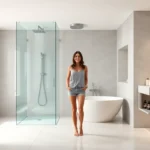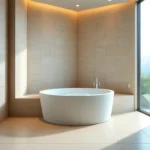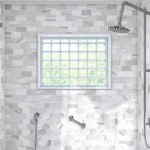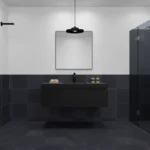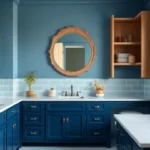Dealing with a windowless bathroom can feel like a design nightmare but we’re here to tell you it doesn’t have to be. These spaces often struggle with poor lighting, limited ventilation, and a cramped atmosphere that makes daily routines less enjoyable than they should be.
The good news? We’ve discovered countless creative answers that’ll transform your windowless bathroom from a dark, stuffy space into a bright and welcoming retreat. From strategic lighting placement to clever ventilation tricks, there are proven methods that work in any budget range.
Whether you’re renovating an existing bathroom or working with a new windowless space, we’ll show you how to maximize natural light alternatives, improve air circulation, and create the illusion of openness. These practical ideas will help you design a bathroom that feels spacious, fresh, and inviting – no window required.
Install Proper Ventilation Systems to Combat Moisture
Proper ventilation becomes absolutely critical in windowless bathrooms where moisture has nowhere to escape naturally. We’ll explore the most effective mechanical answers that keep your bathroom dry and comfortable.
Exhaust Fans for Air Circulation
Exhaust fans serve as the primary defense against moisture buildup in windowless bathrooms. We recommend choosing fans with CFM ratings between 50-110 depending on your bathroom size, with larger spaces requiring higher capacity units. Quality bathroom fans should operate at noise levels below 3 sones to ensure comfortable daily use.
Install your exhaust fan as close to the shower area as possible for maximum moisture removal efficiency. Wall mounted fans work well in smaller bathrooms while ceiling installations provide better coverage in larger spaces. Professional installation ensures proper ductwork that vents directly outside rather than into attic spaces where moisture can cause structural damage.
Energy Star certified exhaust fans consume 60% less energy than standard models while providing superior performance. Replace older fans that produce excessive noise or fail to clear steam within 10 minutes of shower use.
Humidity Sensors for Automatic Control
Humidity sensors eliminate the guesswork from bathroom ventilation by automatically activating fans when moisture levels rise. These smart devices typically trigger at 60-65% relative humidity and continue running until levels drop to 45-50%. We find sensor controlled systems particularly valuable for guest bathrooms and spaces used by multiple family members.
Built in humidity sensors cost $80-200 and integrate directly with new exhaust fan installations. Standalone humidity controllers range from $30-75 and work with existing fans through simple wiring modifications. Advanced models include adjustable sensitivity settings and manual override options for customized operation.
Motion activated humidity sensors provide dual functionality by detecting occupancy and moisture levels simultaneously. This combination ensures ventilation runs during bathroom use and continues operating until humidity returns to safe levels.
Vent Timers for Energy Efficiency
Vent timers optimize energy usage by running exhaust fans for predetermined periods after bathroom use. Standard countdown timers operate for 15-60 minutes and cost $25-50 for basic models. We recommend 30 minute cycles for most bathroom sizes to ensure complete moisture removal without excessive energy consumption.
Digital programmable timers offer multiple preset options including 15, 30, 45, and 60 minute cycles with LED displays showing remaining runtime. Smart timer switches connect to home automation systems for remote control and scheduling capabilities through smartphone apps.
Occupancy sensing timers automatically start when someone enters the bathroom and continue running for preset durations after departure. This hands free operation ensures consistent ventilation while preventing fans from running unnecessarily when bathrooms remain unoccupied for extended periods.
Create Natural Light Effects with Strategic Lighting

Proper lighting becomes the foundation for transforming your windowless bathroom into a bright, welcoming space. We’ll explore three key lighting strategies that work together to eliminate shadows and create the illusion of natural illumination.
LED Strip Lights for Ambient Glow
LED strip lights offer incredible versatility for creating that coveted natural light feeling in windowless bathrooms. We recommend installing these flexible lighting answers under vanities to cast a gentle upward glow that mimics sunlight filtering through a room. Positioning strips around mirrors creates a halo effect that eliminates harsh shadows on your face during daily routines.
Strategic placement along room edges transforms the entire space by washing walls with soft illumination. We’ve found that warm white LED strips (3000K color temperature) provide the most natural looking ambient glow. The key lies in hiding the actual LED strips behind molding or in recessed channels to create seamless light distribution without visible fixtures.
Recessed Ceiling Lights for Even Distribution
Recessed ceiling lights serve as your primary light source, delivering consistent illumination throughout the entire bathroom space. We position these fixtures in a grid pattern to eliminate dark corners and ensure every area receives adequate lighting. The even distribution these lights provide makes windowless bathrooms feel significantly brighter and more spacious.
Choosing the right beam angle becomes crucial for optimal coverage in compact spaces. We recommend 40 degree beam angles for general lighting and narrower 25 degree beams for task areas. Installing dimmer controls allows you to adjust brightness levels throughout the day, creating different moods while maintaining functionality.
Vanity Lighting for Task Illumination
Vanity lighting specifically targets the area around your sink where detailed tasks like shaving and applying makeup occur. We install these fixtures on either side of mirrors rather than above to minimize shadows under the eyes and chin. This side mounting technique ensures even facial illumination that traditional overhead lighting cannot achieve.
Choosing fixtures with frosted glass or fabric shades diffuses the light beautifully while preventing harsh glare. We recommend vanity lights that produce between 1600 to 3000 lumens total to provide sufficient task lighting. The area around your sink transforms into a well lit workspace that rivals any naturally lit bathroom when properly executed.
Use Light Colors and Reflective Surfaces to Brighten Space

Transform your windowless bathroom into a luminous sanctuary by strategically incorporating light colors and reflective materials that amplify available artificial light.
White and Neutral Paint Colors
White paint serves as the foundation for brightening any windowless bathroom. We recommend choosing crisp whites or soft neutrals like pale gray, cream, or beige to maximize light reflection throughout the space. These colors work by bouncing artificial light off walls and surfaces, creating the illusion of a larger and brighter environment.
Light colored paint significantly reduces the confined feeling that often plagues bathrooms without windows. Consider semi-gloss or satin finishes rather than flat paint, as these sheens reflect more light while providing better moisture resistance for bathroom environments.
Glossy Tile Finishes
Glossy tiles create an instant brightness boost by reflecting light from every angle in your windowless bathroom. We suggest incorporating high-gloss subway tiles, ceramic, or porcelain finishes on walls and backsplashes to maximize light reflection. These surfaces act like subtle mirrors, multiplying the effect of your artificial lighting.
Polished marble or glazed ceramic tiles work exceptionally well for shower surrounds and accent walls. The reflective quality of glossy finishes helps distribute light evenly throughout the space, preventing dark corners and shadows that make small bathrooms feel cramped.
Large Mirrors for Light Reflection
Oversized mirrors function as light multipliers in windowless bathrooms by reflecting and amplifying artificial light sources. We recommend installing mirrors that span the entire width of your vanity or creating a mirror wall to dramatically increase perceived space and brightness.
Strategic mirror placement doubles your lighting effectiveness without requiring additional fixtures. Consider placing mirrors opposite light sources or installing mirrored cabinet doors to create continuous reflection throughout the bathroom. Multiple mirrors positioned at different heights can further enhance light distribution while adding visual depth to the space.
Add Artificial Greenery for a Fresh Feel

Artificial plants offer an excellent solution for windowless bathrooms that need a touch of nature without the challenges of maintaining real vegetation. We’ve found that incorporating greenery into these spaces creates an inviting atmosphere while avoiding the maintenance requirements that real plants demand.
Low-Maintenance Artificial Plants
Low-maintenance artificial plants are ideal for windowless bathrooms because they remain vibrant without natural light and require minimal upkeep. We recommend selecting plants made from high-quality materials that won’t fade or deteriorate in humid conditions. Ferns, eucalyptus, and small potted succulents work particularly well as artificial alternatives since they provide the fresh, organic look you’re seeking.
Quality artificial foliage eliminates the worry of watering schedules or proper lighting conditions that real plants require. We suggest choosing pieces with realistic textures and colors that complement your bathroom’s existing color scheme. Dusting these plants occasionally is typically all the maintenance they’ll need to keep looking their best.
Hanging Planters for Vertical Interest
Hanging planters create vertical interest while drawing the eye upward and maximizing limited space in windowless bathrooms. We’ve observed that vertical arrangements using artificial greenery can make bathrooms feel larger and more ever-changing. Suspended planters work especially well in corners or near the shower area where floor space is premium.
Mounting options include ceiling hooks, wall brackets, or tension rods that don’t require permanent installation. We recommend varying the heights of multiple hanging planters to create visual depth and movement. Trailing plants like artificial ivy or pothos work beautifully in hanging arrangements and add softness to hard bathroom surfaces.
Bathroom-Safe Greenery Options
Bathroom-safe greenery options should prioritize materials that are resistant to humidity and easy to clean for optimal performance. We always recommend artificial plants made from plastic or silk since they’re commonly used in bathrooms due to their durability and moisture resistance. Modern artificial foliage designed specifically for high-humidity environments offers the most reliable performance.
Look for plants with antimicrobial treatments or UV-resistant coatings that prevent mold growth and color fading. Wall-mounted planters and hanging arrangements provide both aesthetic and practical benefits in windowless bathrooms while contributing to a sense of freshness and wellbeing. We suggest avoiding materials like paper or untreated fabric that could deteriorate quickly in humid bathroom conditions.
Install Skylights or Solar Tubes for Natural Light

Installing roof-mounted light sources transforms windowless bathrooms by bringing genuine natural light into these challenging spaces. These answers work particularly well when combined with the lighting strategies and reflective surfaces we’ve already discussed.
Traditional Skylights for Direct Sunlight
Traditional skylights offer the most dramatic lighting transformation for windowless bathrooms with accessible roof access. We recommend positioning skylights directly above key areas like the vanity or shower to maximize natural light distribution throughout the day. Installing these roof windows creates an open, airy feeling that artificial lighting simply can’t replicate.
Waterproofing becomes critical when we install skylights in moisture-rich bathroom environments. Professional installation ensures proper flashing and sealing to prevent leaks while maintaining the structural integrity of your roof. Fixed skylights work best for most bathroom applications since they don’t compromise weather resistance like opening models might.
Double-glazed units provide better insulation and reduce condensation issues that can plague bathroom skylights. We suggest choosing skylights with built-in blinds or shades to control privacy and light levels when needed. Energy-efficient models help maintain comfortable temperatures while reducing heating and cooling costs.
Solar Tubes for Compact Spaces
Solar tubes funnel sunlight from the roof down through reflective aluminum tubing to illuminate compact bathrooms where traditional skylights aren’t feasible. These systems work exceptionally well in smaller spaces or when structural limitations prevent larger skylight installations. We find solar tubes particularly effective in powder rooms and guest bathrooms.
Installing solar tubes requires minimal roof disruption compared to traditional skylights since they use a smaller 10-14 inch roof opening. The reflective tubing captures and redirects sunlight even on cloudy days, providing consistent natural illumination. Most solar tube systems include a ceiling fixture that distributes light evenly across the bathroom space.
Flexible solar tubes navigate around roof obstacles like HVAC equipment or structural beams that would block traditional skylight placement. We recommend choosing models with light kits that automatically switch to LED illumination when natural light becomes insufficient. These hybrid systems ensure consistent lighting throughout all hours of use.
Light Wells for Basement Bathrooms
Light wells create natural lighting answers for basement bathrooms by installing large skylight systems in the floor above the bathroom space. We design these installations to bring sunlight down through multiple levels, making them ideal for below-grade bathroom renovations. The light well approach works best when the bathroom sits directly beneath a room with exterior access.
Constructing light wells requires important structural modifications including reinforced openings and proper waterproofing between floor levels. Professional engineering ensures the installation doesn’t compromise the structural integrity of the upper floor while creating effective light transfer. We recommend incorporating frosted or textured glass to maintain privacy between floor levels.
Safety glass installations protect against accidental damage while maintaining light transmission in these large openings. Multiple smaller light wells often work better than single large installations for distributing light evenly across basement bathroom spaces. These systems combine beautifully with the reflective surfaces and light color schemes we’ve previously discussed to maximize the natural light effect.
Choose Moisture-Resistant Materials and Finishes

Selecting the right materials becomes crucial when designing a bathroom without natural ventilation. We’ll explore three essential categories that protect your space from moisture damage while maintaining style and functionality.
Waterproof Flooring Options
Luxury vinyl plank (LVP) tops our list for windowless bathrooms due to its exceptional water resistance and easy maintenance. This flooring mimics wood or stone appearances while providing complete waterproof protection, making it ideal for high-moisture environments without windows.
Porcelain tile offers another excellent waterproof solution with superior durability and style versatility. We recommend large format tiles to minimize grout lines, reducing areas where moisture can penetrate and creating a cleaner, more seamless appearance.
Epoxy coatings provide the ultimate waterproof barrier for concrete floors in basement or industrial style bathrooms. These coatings create a completely sealed surface that resists water, stains, and chemicals while offering customizable colors and finishes.
| Flooring Type | Water Resistance | Maintenance Level | Style Options |
|---|---|---|---|
| Luxury Vinyl Plank | 100% Waterproof | Low | High |
| Porcelain Tile | 100% Waterproof | Medium | Very High |
| Epoxy Coatings | 100% Waterproof | Low | Medium |
Mold-Resistant Paint Types
High-humidity labeled paints specifically formulated for bathrooms provide essential mold and mildew protection in windowless spaces. We recommend choosing paints with antimicrobial additives that actively prevent fungal growth in damp conditions.
Semi-gloss finishes offer superior moisture resistance compared to flat paints while maintaining easy cleaning capabilities. These finishes reflect more light, which helps brighten windowless bathrooms while providing a protective barrier against humidity.
Bathroom-exact primer creates the foundation for mold resistance by sealing the wall surface before applying topcoat paint. We suggest using primers with moisture-blocking properties to prevent water penetration into drywall or plaster surfaces.
Sealed Natural Stone Surfaces
Granite countertops bring luxury to windowless bathrooms when properly sealed with penetrating sealers every 1-2 years. We recommend testing the seal regularly by placing water drops on the surface to ensure continued protection against moisture damage.
Quartz surfaces provide naturally non-porous protection without requiring regular sealing maintenance. These engineered stones resist moisture, stains, and bacteria while offering consistent patterns and colors perfect for windowless bathroom designs.
Sealed stone flooring requires professional installation with appropriate sealers to prevent water absorption and staining. We advise choosing dense stones like granite or slate over porous options like travertine for optimal moisture resistance in windowless environments.
Incorporate Scent Solutions for Air Freshness

Fresh air circulation in windowless bathrooms requires strategic scent management to maintain a pleasant environment. We’ll explore three effective approaches to keep your bathroom smelling clean and inviting without natural ventilation.
Essential Oil Diffusers
Essential oil diffusers offer a sophisticated solution for maintaining pleasant aromas in windowless bathrooms. We recommend placing ultrasonic diffusers on countertops or shelves away from direct water exposure to prevent damage. Eucalyptus and tea tree oils provide natural antimicrobial properties while creating a spa-like atmosphere.
Battery-powered models work exceptionally well in bathrooms since they don’t require electrical outlets near water sources. Citrus blends like lemon and orange effectively mask odors while providing an energizing scent for morning routines. Lavender and peppermint combinations create a relaxing ambiance for evening baths. Diffusers release pleasant scents continuously and help neutralize bathroom odors naturally.
Automatic Air Freshener Systems
Automatic air freshener systems provide consistent fragrance without manual intervention in windowless spaces. Motion-activated dispensers detect movement and release measured amounts of fragrance, ensuring fresh scents when you enter the bathroom. Timer-based units spray at predetermined intervals, typically every 15 to 30 minutes, maintaining steady air quality throughout the day.
Wall-mounted systems save counter space while providing reliable coverage for medium to large bathrooms. Battery-operated models offer flexible placement options without requiring electrical connections. Smart dispensers with adjustable intensity settings let you customize fragrance levels based on bathroom size and personal preferences. These systems ensure continuous freshness without manual intervention and work particularly well in guest bathrooms.
Natural Odor Absorbers
Natural odor absorbers provide chemical-free answers for maintaining fresh air quality in windowless bathrooms. Activated charcoal bags placed in corners or behind toilets effectively neutralize odors and absorb excess moisture from the air. Baking soda containers with perforated lids work similarly, requiring replacement every 30 days for optimal effectiveness.
Zeolite rocks offer superior odor absorption and can be recharged by placing them in direct sunlight monthly. Bamboo charcoal products combine moisture absorption with natural air purification properties. Coffee grounds in small bowls absorb strong odors while adding a subtle, pleasant aroma. Natural absorbents help neutralize odors and absorb excess moisture without introducing artificial fragrances or chemicals into your bathroom environment.
Maximize Storage to Reduce Clutter

Smart storage answers transform windowless bathrooms from cramped spaces into organized retreats. We’ll explore vertical storage options that keep surfaces clear while maintaining the bright, open atmosphere we’ve been creating.
Wall-Mounted Cabinets
Wall-mounted cabinets offer elevated storage that keeps items off countertops and makes cleaning significantly easier. We recommend installing these units at eye level or higher to maximize floor space while providing easy access to daily essentials. Modern wall-mounted options include medicine cabinets with built-in lighting, floating vanities with concealed storage, and sleek minimalist designs that complement your bathroom’s aesthetic.
Installing cabinets 12-18 inches above the countertop creates optimal functionality without overwhelming the space. We suggest choosing units with mirrored fronts to double their light-reflecting benefits, effectively serving both storage and illumination purposes in your windowless bathroom.
Over-Toilet Storage Answers
Over-toilet storage utilizes vertical space efficiently, providing extra room for linens, toiletries, and decorative elements without encroaching on limited floor area. We find ladder-style shelving units particularly effective, offering multiple tiers for organizing towels, baskets, and bathroom supplies. Cabinet-style over-toilet storage provides concealed organization for items you’d prefer to keep hidden.
These answers typically add 2-3 feet of vertical storage space above your toilet tank. We recommend securing all over-toilet units to wall studs for stability, especially when storing heavier items like towel stacks or cleaning supplies.
Built-In Shelving Systems
Built-in shelving systems can be installed in recessed walls or above doorways, adding functional storage for towels or baskets while keeping the space organized and visually uncluttered. We often recommend creating recessed niches in shower walls for shampoo and soap storage, eliminating the need for hanging caddies that can make small spaces feel cramped.
Above-door shelving takes advantage of often-overlooked vertical space, perfect for storing extra toilet paper, cleaning supplies, or decorative baskets. We suggest installing these systems during renovation projects when wall access is easier, though retrofit options work well for existing bathrooms. Corner built-ins maximize awkward spaces that might otherwise remain unused, turning dead zones into valuable storage real estate.
Consider Glass Block Windows for Privacy with Light

Glass block windows offer an excellent solution for adding natural light while maintaining privacy in your windowless bathroom. These modular glass bricks allow sunlight to filter through while obscuring direct views, creating the perfect balance of brightness and discretion.
Textured Glass Options
Frosted glass panels provide privacy without sacrificing natural light in your bathroom renovation. We recommend etched patterns that scatter light beautifully while blocking visibility from outside. Patterned glass options include geometric designs, floral motifs, and abstract textures that complement various bathroom styles.
Adhesive films offer a budget-friendly DIY solution for existing windows or glass surfaces. These removable films come in frosted, bamboo, and stained glass patterns that you can easily install yourself. Spray applications like frosted glass paint create permanent textured finishes for a more professional appearance.
Partial panel installations work well when you want to maintain some clear viewing areas while adding privacy. We suggest installing textured glass on the lower portion of windows while keeping the upper section clear for maximum light transmission.
Installation Requirements
Professional installation ensures proper structural integrity and building code compliance for glass block windows. Most regions require permits for window modifications, especially in load-bearing walls where structural support becomes critical. Proper sealing prevents moisture infiltration that could damage surrounding wall materials.
Measurements and planning require precise calculation of existing wall dimensions and window openings. We recommend hiring contractors experienced with glass block installation since these systems need exact mortar types and reinforcement methods. Operable windows may be required in some areas for emergency egress or ventilation purposes.
Ventilation considerations become important since glass block windows typically don’t open like traditional windows. You’ll need adequate exhaust fan capacity to compensate for reduced natural airflow through fixed glass installations.
Design Variations
Pattern selections include wave, diamond, and cross-hatch designs that create different light diffusion effects. Colored glass blocks in blue, green, or amber tones add visual interest while maintaining privacy functions. Horizontal arrangements create wider visual lines, while vertical configurations make ceilings appear taller.
Decorative frames in bronze, chrome, or white finishes complement your existing bathroom hardware and fixtures. We suggest coordinating frame colors with faucets and cabinet hardware for a cohesive design appearance.
Supplementary treatments like interior shutters or cafe curtains provide additional privacy control when needed. These additions work particularly well in guest bathrooms where privacy preferences may vary among users.
Conclusion
Transforming a windowless bathroom doesn’t have to be overwhelming or expensive. We’ve shown you that with the right combination of strategic lighting ventilation answers and thoughtful design choices you can create a space that feels bright airy and welcoming.
Whether you’re installing LED strips adding a skylight or simply incorporating mirrors and light colors each improvement builds toward a more functional and beautiful bathroom. The key is addressing the core challenges of moisture lighting and air circulation systematically.
Your windowless bathroom has incredible potential waiting to be unlocked. Start with one or two answers that fit your budget and watch as your space transforms into the bright inviting retreat you’ve always wanted.
Frequently Asked Questions
How can I improve ventilation in a windowless bathroom?
Install an exhaust fan with appropriate CFM rating based on your bathroom size, preferably an Energy Star certified model. Consider adding humidity sensors that automatically activate fans when moisture levels rise, or vent timers that run for set periods after use. These systems effectively combat moisture buildup and ensure proper air circulation without windows.
What lighting techniques work best in windowless bathrooms?
Use three key strategies: LED strip lights under vanities and around mirrors for ambient glow, recessed ceiling lights for even distribution, and vanity lighting mounted on mirror sides for task illumination. This combination creates the illusion of natural light and eliminates shadows, making the space feel brighter and more spacious.
What colors and finishes should I use in a windowless bathroom?
Paint walls in crisp whites or soft neutrals with semi-gloss or satin finishes for moisture resistance and light reflection. Use glossy tiles like high-gloss subway or polished marble for walls and backsplashes. Add large mirrors strategically to reflect and amplify artificial light, creating a more luminous and spacious environment.
Can I add natural light to a windowless bathroom?
Yes, consider installing skylights above key areas like vanities or showers for dramatic lighting transformation. Solar tubes are excellent for compact spaces, funneling sunlight through reflective tubing. Light wells work for basement bathrooms. All options require professional installation to ensure waterproofing and structural integrity.
What plants work well in windowless bathrooms?
Choose low-maintenance artificial plants like ferns and succulents that don’t require natural light. Use hanging planters to create vertical interest and make the space feel larger. Select bathroom-safe greenery made from durable, humidity-resistant materials that are easy to clean, ensuring a fresh atmosphere without real plant maintenance challenges.
How do I manage odors in a windowless bathroom?
Use essential oil diffusers with battery-powered models for spa-like ambiance, automatic air freshener systems with motion-activated or timer-based dispensers, and natural odor absorbers like activated charcoal and baking soda. These solutions neutralize odors, absorb excess moisture, and maintain pleasant air quality without chemical dependency.
What storage solutions work best for windowless bathrooms?
Install wall-mounted cabinets to keep countertops clear, over-toilet storage units to utilize vertical space efficiently, and built-in shelving systems in recessed walls or above doorways. These smart storage solutions reduce clutter while maintaining the bright, open atmosphere essential for making windowless bathrooms feel spacious and organized.
What flooring options are best for windowless bathrooms?
Choose waterproof flooring like luxury vinyl plank, porcelain tile, or epoxy coatings to protect against moisture damage while maintaining style. Use mold-resistant paint types and sealed natural stone surfaces such as granite and quartz. These moisture-resistant materials ensure durability and enhance aesthetics in high-humidity environments.
Can glass blocks provide privacy and light in windowless bathrooms?
Yes, glass block windows allow natural light while maintaining privacy through textured options like frosted and patterned glass. Professional installation ensures structural integrity and building code compliance. Consider design variations with different patterns and colors, plus supplementary treatments like interior shutters for additional privacy control when needed.



